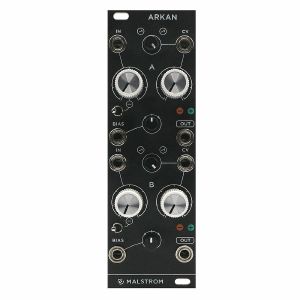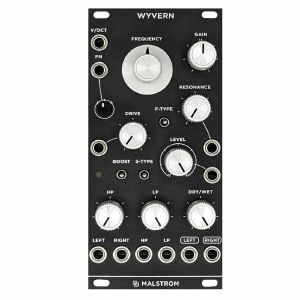Receive new release alerts for Malstrom Audio
Filter
Equipment
Format
Featured
Price
Tags
Items 1 to 2 of 2 on page 1 of 1
Malstrom Arkan Dual Voltage Polarizer Module (polarizer synth module)
Cat: 946070 Rel: 21 Jul 23
Dual voltage polarizer module - 8HP
Notes: Arkan
Dual Voltage Polarizer
You may have heard this before: "You can never have enough VCAs". A voltage polarizer (also known as a bipolar VCA or a 4-quadrant multiplier) is often viewed as the VCA better suited for CV. As it can be used as a unipolar VCA and it allows you to invert a signal when it is modulated with a negative voltage. Resulting in interesting movements in your modulations.
What sets Arkan apart from other voltage polarizers is the curvature control, a feature usually only seen in unipolar VCAs. By taking a different approach to the classic voltage polarizer circuitry, Malstrom have devised a unique solution that provides a new way to shape your audio and CV. The non-linearity of the polarizer also makes Arkan really good at reaching silence when presented with a 0V CV signal.
At audio rate, Arkan acts as a ring-modulator with four controls to change timbres.
Boosting adds odd harmonics (symmetrical distortion), while offsetting adds even harmonics (asymmetrical distortion). The modulation curve changes ring modulation sharpness, and modulation strength determines the carrier dominance.
Two identical channels with carefully selected features will make Arkan your go-to modulation control hub. Arkan is especially useful for common utility duties such as mixing, scaling, inverting and offsetting. As well as CV modulation, feedback patching, and waveshaping. All this makes Arkan a very versatile tool that will certainly have a place in your patch!
Features (per channel)
- Input attenuation with inverter switch gives you more precision and range, with voltage inversion and quick silencing.
- Bias input with attenuverter control to offset your input signal or mix/invert another signal.
- CV input with curvature control allows you to shape the polarizer and improve its 0V attenuation.
- CV modulation control to fade in the modulator, allowing you to determine the amount of modulation.
- Voltage gain and polarity led indicators showing you exactly what is happening under the radar.
- Output normalled internally and externally (to other Arkans) to easily mix signals.
Additional features
Optional signal boost (x4 / +12dB) via switch on the PCB to increase voltages when needed.
5V or 10V voltage reference selection for bias voltage and CV input range to adjust Arkan to your system.
Dimensions
- 8HP.
- 28mm, Skiff-friendly.
Power consumption
- 90mA @ +12V.
- 85mA @ -12V.
I/O specs
- All inputs DC coupled.
- All inputs handle audio signals.
- All inputs have 100k input impedance. - All inputs have +-10V Input range.
- CV range +-5V or +-10V.
- Bias Voltage range +-5V or +-10V.
- Boost gain x1 or x4.
- All inputs are overvoltage protected.
- Keyed power header.
- Reverse power protection.
… Read moreDual Voltage Polarizer
You may have heard this before: "You can never have enough VCAs". A voltage polarizer (also known as a bipolar VCA or a 4-quadrant multiplier) is often viewed as the VCA better suited for CV. As it can be used as a unipolar VCA and it allows you to invert a signal when it is modulated with a negative voltage. Resulting in interesting movements in your modulations.
What sets Arkan apart from other voltage polarizers is the curvature control, a feature usually only seen in unipolar VCAs. By taking a different approach to the classic voltage polarizer circuitry, Malstrom have devised a unique solution that provides a new way to shape your audio and CV. The non-linearity of the polarizer also makes Arkan really good at reaching silence when presented with a 0V CV signal.
At audio rate, Arkan acts as a ring-modulator with four controls to change timbres.
Boosting adds odd harmonics (symmetrical distortion), while offsetting adds even harmonics (asymmetrical distortion). The modulation curve changes ring modulation sharpness, and modulation strength determines the carrier dominance.
Two identical channels with carefully selected features will make Arkan your go-to modulation control hub. Arkan is especially useful for common utility duties such as mixing, scaling, inverting and offsetting. As well as CV modulation, feedback patching, and waveshaping. All this makes Arkan a very versatile tool that will certainly have a place in your patch!
Features (per channel)
- Input attenuation with inverter switch gives you more precision and range, with voltage inversion and quick silencing.
- Bias input with attenuverter control to offset your input signal or mix/invert another signal.
- CV input with curvature control allows you to shape the polarizer and improve its 0V attenuation.
- CV modulation control to fade in the modulator, allowing you to determine the amount of modulation.
- Voltage gain and polarity led indicators showing you exactly what is happening under the radar.
- Output normalled internally and externally (to other Arkans) to easily mix signals.
Additional features
Optional signal boost (x4 / +12dB) via switch on the PCB to increase voltages when needed.
5V or 10V voltage reference selection for bias voltage and CV input range to adjust Arkan to your system.
Dimensions
- 8HP.
- 28mm, Skiff-friendly.
Power consumption
- 90mA @ +12V.
- 85mA @ -12V.
I/O specs
- All inputs DC coupled.
- All inputs handle audio signals.
- All inputs have 100k input impedance. - All inputs have +-10V Input range.
- CV range +-5V or +-10V.
- Bias Voltage range +-5V or +-10V.
- Boost gain x1 or x4.
- All inputs are overvoltage protected.
- Keyed power header.
- Reverse power protection.
1 in stock $206.91
Click for better price!
or call +44 20 7424 1960
quote 946070
quote 946070
Malstrom Wyvern Stereo Saturation Controller Module (modular synthesiser)
Cat: 1010777 Rel: 04 Apr 24
Stereo saturation controller module - 12HP
Notes: Saturation is a sound designer's best friend. As applying saturation to a sound can make it sound warm, rich and defined. But without any other processing the opposite can happen; making the sound harsh, destroyed and undefined. An often used technique in music production is to saturate specific parts of the spectrum, adding harmonics to enrich the sound but not lose its original quality.
Wyvern takes this technique and makes it a creative sound design tool. When deconstructed Wyvern is built out of a specific chain: Filter EQ, Saturation, VCA, Dual Filter, Dry/Wet Balance. Different combinations of these stages can be used for a variety of sound design and patch situations. And it is all in stereo, so you can apply it to your final mix and stereo signals with ease too!
The Filter EQ stage has a high-shelf, low-shelf and bell curve to boost or diminish parts of the spectrum. When the gain is set to a minimum the EQ curves turn into low-pass, high-pass and notch respectively. A Resonance control puts emphasis on a certain frequency, or it can be used to make Wyvern scream. This is then sent to a Saturation stage. The Drive control sets the amount of Saturation of one of the three
Saturation types
Soft clipping puts more emphasis on the third harmonic and compresses the sound.
Hard clipping puts emphasis on odd harmonics. Finally an Allpass distortion adds phase shifts and distortion. The Saturation stage also has a level control which can be used to decrease the gain after saturation is applied and can function as a unipolar VCA. The Saturation stage is also accompanied with a clip indicator led and a boost switch to scale input signal correctly or simply add more or less harmonics.
The Post-Saturation stage is a high-pass and low-pass combo. Allowing you to select a frequency band from the previous stages. Along with a balance control to adjust the balance between the dry and wet signal.
Whether you are looking to destroy your sound or go for subtle analogue warmth; Wyvern has got you covered. Even when not used for saturation alone. It can be a Stereo Tone Controller, EQ, Filter, VCA and Phaser, all and anything in between. Making it a very fun and powerful sound design tool!
Features
- Filter EQ with Low-shelf, High-shelf, Bell, Low-pass, High-pass and Notch curves.
- Resonance to add emphasis on a frequency or to make it scream.
- Soft clipping, Hard clipping and Allpass distortion for a variety of flavors.
- Boost switch and clip indicator led to set Saturation scale.
- Level and VCA to adjust level while Saturation amount remains the same.
- High-pass and Low-pass combo to select a part of the spectrum.
- Dry/wet control to dial in the right amount of processed signal.
- Gain with increased and adjustable center detent position.
- V/oct tracking with temperature compensation.
165mA @ +12V // 150mA @ -12V
… Read moreWyvern takes this technique and makes it a creative sound design tool. When deconstructed Wyvern is built out of a specific chain: Filter EQ, Saturation, VCA, Dual Filter, Dry/Wet Balance. Different combinations of these stages can be used for a variety of sound design and patch situations. And it is all in stereo, so you can apply it to your final mix and stereo signals with ease too!
The Filter EQ stage has a high-shelf, low-shelf and bell curve to boost or diminish parts of the spectrum. When the gain is set to a minimum the EQ curves turn into low-pass, high-pass and notch respectively. A Resonance control puts emphasis on a certain frequency, or it can be used to make Wyvern scream. This is then sent to a Saturation stage. The Drive control sets the amount of Saturation of one of the three
Saturation types
Soft clipping puts more emphasis on the third harmonic and compresses the sound.
Hard clipping puts emphasis on odd harmonics. Finally an Allpass distortion adds phase shifts and distortion. The Saturation stage also has a level control which can be used to decrease the gain after saturation is applied and can function as a unipolar VCA. The Saturation stage is also accompanied with a clip indicator led and a boost switch to scale input signal correctly or simply add more or less harmonics.
The Post-Saturation stage is a high-pass and low-pass combo. Allowing you to select a frequency band from the previous stages. Along with a balance control to adjust the balance between the dry and wet signal.
Whether you are looking to destroy your sound or go for subtle analogue warmth; Wyvern has got you covered. Even when not used for saturation alone. It can be a Stereo Tone Controller, EQ, Filter, VCA and Phaser, all and anything in between. Making it a very fun and powerful sound design tool!
Features
- Filter EQ with Low-shelf, High-shelf, Bell, Low-pass, High-pass and Notch curves.
- Resonance to add emphasis on a frequency or to make it scream.
- Soft clipping, Hard clipping and Allpass distortion for a variety of flavors.
- Boost switch and clip indicator led to set Saturation scale.
- Level and VCA to adjust level while Saturation amount remains the same.
- High-pass and Low-pass combo to select a part of the spectrum.
- Dry/wet control to dial in the right amount of processed signal.
- Gain with increased and adjustable center detent position.
- V/oct tracking with temperature compensation.
165mA @ +12V // 150mA @ -12V
! low stock $372.38
Click for better price!
or call +44 20 7424 1960
quote 1010777
quote 1010777
Items 1 to 2 of 2 on page 1 of 1

 USD
USD







